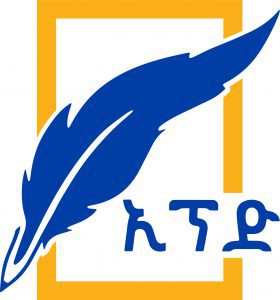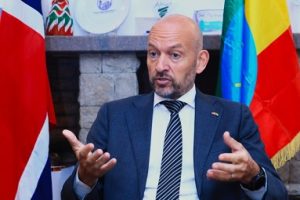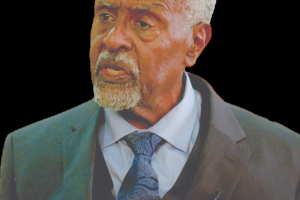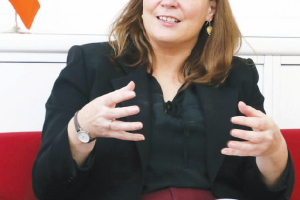
Today, The Ethiopian Herald is honored to feature Mr. Zlatan Milišić, Ethiopia’s Representative and Country Director for the World Food Programme (WFP). With over 30 years of experience in humanitarian and development work, Mr. Milišić brings a wealth of knowledge and leadership to one of the most critical missions in the country.
A native of Bosnia and Herzegovina, Mr. Milišić has served across multiple continents—including North, West, East, and Southern Africa; Central Asia; the Middle East; and Eastern Europe— throughout his distinguished career with the United Nations system. Before taking up his current role in Ethiopia, he served as the UN Resident Coordinator in the United Republic of Tanzania, where he led the implementation of the United Nations Sustainable Development Cooperation Framework involving 24 UN agencies.
His extensive WFP career includes serving as Representative and Country Direc-tor in several complex contexts, such as Afghanistan, Mali, Libya, Lebanon, Somalia, Burundi, Kyrgyzstan, and Tajikistan, as well as holding key leadership roles at WFP Headquarters and Regional Bureaus. Mr. Milišić began his UN journey with the United Nations High Commissioner for Refugees (UNHCR) in Bosnia and Herzegovina, followed by assignments with WFP in Rwanda and South Sudan. Before joining the United Nations, he practiced law privately in the former Yugo-slavia.
He holds a bachelor’s degree in law from the University of Sarajevo and a Master of Arts in International Politics and Security Studies from the University of Bradford, United Kingdom. Fluent in English, French and Italian, Mr. Milišić is also a proud husband and father of three.
In this exclusive interview, Mr. Milišić shares insights into WFP’s current humanitarian and development initiatives in Ethiopia, discusses the evolving relationship between development partners and the government, and reflects on the implications of the U.S. administration’s decision to cut USAID funding. His thoughtful perspectives offer timely and valuable reflections on the challenges and opportunities ahead.
We invite our readers to delve into this engaging conversation. Enjoy the read.
What are WFP’s key priorities in addressing humanitarian needs in Ethiopia? Moreover, could you briefly outline your five-year strategy including plans for expansion or downsizing and the reasons behind these decisions?
Our activities are mainly focused on bridging the gap between humanitarian development and peace objectives. And our new five-year Country Strategic Plan, which will be launched later in the year, demonstrates that very well.
So, we have humanitarian activities because there are humanitarian needs with refugees, with displaced people, with returnees, with people affected by floods, earthquakes and several other emergencies that are either man-made or caused by natural disasters.
However, we recognize that putting out fires is not a solution, it is not sustainable, and it also is not necessarily the best use of resources.
Our focus is always on building resilience of communities and also resilience of systems to be able to withhold or absorb some of these shocks that may occur.
So, our five-year strategy and our annual programmes are always focused on trying to combine those activities in parallel, make them complementary and in the next five years they will be heavily focused on building, supporting, strengthening food systems.
But when we have limited resources, we will try to optimize food rations and/or focus on the most severely food insecure people.
Fortunately, so far, we have been able to assist them all. But when we cut rations, we take so many factors into consideration, and that’s why we prioritize our humanitarian assistance.
And I must say that I’m quite happy that so far, during these last relatively tense three months, we have assisted all the people we intended to assist except with the unfortunate situation we had to cut volume of food rations.
These days, emergencies like recurrent droughts, conflicts, and climate crisis are common. How do you address those emergencies?
Well, as I said, we first try to preempt – I can’t say prevent them – and make communities more ready, prepared, and resilient to deal with the situation when it takes place. We know that droughts are occurring almost every other year.
But how do you know that droughts will happen?
The rains are not the same across the country or even across the region. So sometimes rains seem to be good, but there are a lot of pockets where it’s very dry. So, one of the ways of knowing this and trying to preempt is through “anticipatory action”. Once we start getting the signals that rains might not perform well, we will start already putting in place these projects and activities to help communities deal with expected drought particularly for example, for pastoralist water activities, irrigation systems for some agricultural areas.
So then, if drought comes, they have already been prepared to minimize, reduce the impact.
How do you describe the relationship or your partnership with the government?
Well, of course, in every country, the United Nations is there to support the government, be it on humanitarian objectives or on the development objectives. Since WFP has been working well in this country for decades, I think that it’s very clear that we have a very good relationship with the government of Ethiopia. And it’s important to mention that the government of Ethiopia is one of those governments that genuinely leads and also addresses various development and humanitarian needs.
But I believe that they also value our engagement and our contributions because we have, through the decades, really tried to make it helpful and constructive. I believe that WFP’s resilience activities have advanced the most in Ethiopia compared to most other countries.
From my experience with WFP for 30 years, I have never seen a country with such a diverse portfolio between humanitarian development and so many innovative, even new ways of working on resilience as I have seen in Ethiopia.
We are very proud that we are often chosen as an example in various international forums. And that’s why we have very strong dialogue on different themes with different government offices. For our School Feeding Programme, the Ministry of Education, for our Nutrition Programme, Ministry of Health, and emergencies, humanitarian needs, Ethiopia Disaster Risk Management Commission.
We have achieved a lot in this country together. For example, food security is covered by EDRMC, WFP and a consortium of NGOs called JEOP.
I’m very proud of our partnership. Last year, despite various challenges such as operational pauses, security issues, logistical difficulties, and new crises, we continued to make progress. We managed to assist 8.2 million people last year, which is more than what we had planned because there were certain emergencies that we didn’t expect.
And every month we reach 90%, 95%, 97% of the target population we planned. And that demonstrates that our partnership is working well. But yes, we recognize sometimes we need to work more on aligning ourselves even more behind certain things because let’s say, the more of us speak together with the one voice, with the same narrative, the stronger the message is.
Now let’s look at the global situation, the economic challenge at global level. Considering the situation, how does WFP secure funding and resource to sustained operation in Ethiopia?
I would say in the last few years, we have had reasonably strong resource mobilization and support. I think that’s mainly due to the fact that we are really a solid, robust and resilient organization which focuses on results and outcomes rather than on processes.
We’re quite fast in responding. In most emergencies, we are among the first responders together with Ethiopian Disaster Risk Management Commission (EDRMC) in Ethiopia. We also have this portfolio of food security, food systems and nutrition activities that are interlinked and that crosses between humanitarian to resilience and development activities.
So, as a result, there are different donors who prefer to support different initiatives that also fit well into our portfolio. Some may want to support humanitarian activities, others nutrition, some school feeding, some capacity strengthening in the country, and others resilience activities that include agricultural productivity and infrastructure improvements. We even have donors who support us as a service provider to humanitarians through our United Nations Humanitarian Air Service (UNHAS) flights or through our logistics cluster to store and deliver humanitarian workers and materials for other agencies. Ideally, we would like to see our donors provide us with funds so that we can use them whenever we need them the most.
Now, we are currently, as you said, at a globally difficult and challenging time in terms of resources because some donors are stopping certain activities. Other donors are reducing overall budgets, and that’s going to affect everybody. It is probably affecting us more in Ethiopia compared to places where the humanitarian crisis is even more acute, where people are hungrier and starving due to fewer resources. However, we will continue to broaden our base, trying to bring in non-traditional donors and explore new ways with the private sector and financial institutions, for example, to support the government where we can.
Last year, we were a third-party implementer for the government of Ethiopia for the World Bank funding of the Productive Safety Net Program (PSNP) in Tigray because it could not be done otherwise. We assisted over 1.3 million people with a US$65 million program. That was a significant number in Tigray right after the conflict.
We were very proud to have been selected for such an important task by the government. We stand ready to do that at any time with our expertise, resources, and determination when we are needed.
In your opinion, Mr. Milisic, how do you see President Trump’s Administration’s decision in cutting USAID funds and how does this decision impact your operation in Ethiopia?
I’m hoping that this review that is taking place by the U.S. administration will conclude that there have been some good work done through the support and funding of U.S. and that they will endorse continuation of many of those projects. Or at least those that are critical sometimes for saving lives and more humanitarian in nature because they’re definitely more acute.
I think, we as WFP, and as an agency that demonstrates its value, its status of being a partner of choice, its focus on different types of food security and related activities, has resulted in being certainly less affected so far in Ethiopia than, I would say, many other organizations.
Now the challenge for us and the worry for me is that we don’t know what is going to happen for the rest of the year. If the donors follow the trend of the last one, two, three years in a reasonable way compared to the needs, we should be fine to assist those beneficiaries, some six million plus, that we plan to assist this year. About three and a half million in the first half of the year and about three in the second. So about six million or more in total.
Now, if we get reasonable funding, millions of vulnerable people will benefit. If we don’t, then lives will be under threat. At the moment, we are happy and proud that during these three months, we have reached over 3 million people – more or less all the people with humanitarian needs that we wanted to reach.
So, I’m proud that we have been robust enough, strong enough, credible enough to have done most of our work. But we have had problems of financial nature for months and now they’re reaching even more worrying situation and that’s why food rations are cut across the board.
For the most severely food insecure refugees, we have tried to give them as close to a full ration as we can. But we have cut 60% to the others, which is a big cut but at least reaching them to prevent much serious food insecurity.
The real worry comes that in two or three months, if we don’t get additional resources, we will be slowly, as they say, reducing and stopping our activities of all kinds.
I’m hoping that our donors will continue to support us. Even if they have to cut it, at least we get something from those donors that we didn’t work with before. I hope the US, as a major donor of our activities, and for many other humanitarian activities in the country, would come back with a reasonable amount of resources to support humanitarian needs in Ethiopia in our effort to support the government at national and regional levels in addressing those needs themselves.
If your donors are to supervise your activities, the manner your deliver to the target community, what would they say? In other words, how much is WFP successful in meeting their expectations?
I think that donors usually vote with their money. If they like what they see, if they appreciate what the results are, they continue funding. It doesn’t necessarily mean that if they don’t fund that somebody has failed because as we said, many donors across the world have announced that they’re cutting their donations by 40%, 30%, 20%.
We have had some areas for improvement that we identified. So, we have completely redesigned our food assistance activities in Ethiopia in a way that they’re fully transparent and accountable to our donors. Of course, we provide regular reports, but the main point was that we have made all these processes much more neutral and much more involving the communities that we try to assist. And our control over the resources – the food, the cash – whatever we are distributing has been tightened much more than the case before through different technological and other advanced mechanisms.
We have doubled, I would say, even possibly tripled our monitoring activities. We are using third party monitors who are neutral. We are working with NGOs on targeting of people in need which use local communities and committees to determine who is in need and who might not be. So, between these activities, targeting distribution, marking the bags, checking and doing the monitoring before distributions, after distributions, at the market places to the reports to the donors not only what we achieved, but also what have been the incidents and problems we have had, and what we have done about it, I believe it’s the best way to reassure them that we are doing a good job, and their resources and their money is being spent efficiently and in a manner that minimizes the risk of diversion, fraud and misconduct.
What message do you want to convey for your donors?
I think it is always very important to help people in need and those who are less fortunate. So, I would like to say that we do need more focus on food security and food systems particularly on malnutrition at this time when many donors have decided to start cutting their funding and budgets for this type of humanitarian work.
We will continue to offer humanitarian and resilience assistance and development solutions which we believe will contribute to stability and peace and many other outcomes. But we are currently seeing a worrying level of funding for us to be comfortable that we will be doing our job well in the coming months.
In two to three months, we will be starting to see serious gaps in our assistance at least for our most crucial activities. So, we need more support. And we also need continued dialogue with all our partners, to hear from them what they feel we could do better.
WFP is ready to do what we have been doing as necessary while at the same time we do need the Government and international partners of Ethiopia as well as donors of WFP and other organizations to step up and do more to help us be successful in saving lives, changing lives, protecting lives, improving lives and transforming livelihoods.
Thank you so much
Thank you.
BY WAKUMAN KUDAMA
THE ETHIOPIAN HERALD SATURDAY 19 APRIL 2025





